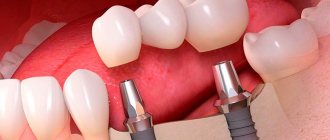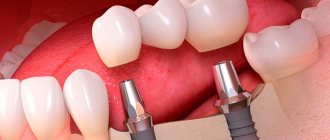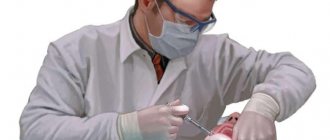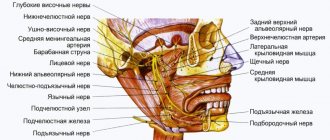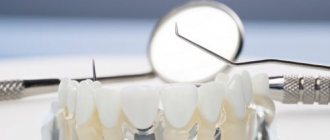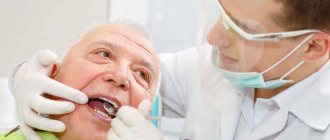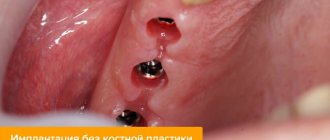The clinics of the German Implantology Center are equipped with the most modern diagnostic equipment necessary to prepare the patient for dental implantation. According to dental market experts, both clinics of the Research Center, located in the Ramenki and Dorogomilovo districts of Moscow, occupy TOP 1 rating 2017-2019
private dental clinics in Moscow and Russia.
Let's see what diagnostics are carried out before implantation in our clinics, without what equipment, procedures and diagnostic data it is currently impossible to prepare qualitatively
for implantation surgery.
The chief physician of the Research Center, implant surgeon Dakhkilgov Magomed Umatgireevich answers these questions:
As an implantologist with more than 20 years of experience
Magomed Umatgireevich, who has made a serious practical contribution to the development of this area in Russia, makes great efforts to ensure that the equipment of clinics meets
leading world standards.
He brought clinics to the TOP1 ratings in Moscow and Russia, which today makes it possible to successfully perform dental implantation even in the most complex clinical cases.
Please note that some of the material is accompanied by a video from our YouTube channel, we recommend spending a little of your precious time and watching the videos, it will be useful. More than 1,000 patients use the recommendations of medical specialists from the Scientific Research Center on YouTube every day
.
Requirements for installing dental implants:
I. Preparatory stage
- Absence of absolute contraindications of the body to the installation of implants
- Absence of inflammatory processes in the maxillofacial area
- Availability of the required volume of bone tissue in the jaws (if there is a deficiency, bone grafting is necessary)
- The implant must be made of a material that is bioinert for the body (titanium, tantalum, zirconium dioxide, ceramics, etc.)
II. Surgical stage
- The implant must be completely immersed in the bone
- Minimum required implant size in diameter and length
- The implant must be along the same axis (coaxial) with the planned tooth
- The implant shaft should extend through the center of the planned tooth
- There must be a minimum required volume of bone tissue around the perimeter of the installed implant (about 2.0 mm)
- The minimum required distance between the tooth and the implant (1.5 mm), also between adjacent implants (3.0 mm)
- The bone around the implant must be protected by fixed attached gum
III. Orthopedic stage
- Precisely manufactured components of the implantation system (dental implant, abutment, abutment screw) and orthopedic structure (crowns on the implant) are adjusted to each other.
- Absence of sharp edges and undercuts in orthopedic structures (crowns and dentures)
- Adequate distribution of occlusal load
To satisfy the required conditions of the surgical stage, it is necessary to have competent planning and be able to transfer it into the oral cavity for its accurate implementation.
Navigation templates with Implant Guide bushings will help us with this. The technology of navigation surgery involves the use of computed tomography (CT) data of teeth and jaws, as well as scanned digital impressions of the patient’s teeth. Based on this data, a virtual plan for dental implantation is developed, taking into account the type, size of implants, area of their implantation, as well as the type of denture. After drawing up a virtual implantation plan and agreeing with the patient, 3D surgical navigation templates with drilling sleeves will be made on its basis.
Surgical implant templates look like thin plates that exactly match the size of the jaw on which surgery is planned.
Using navigation templates for implantation, the surgeon will insert implants with maximum accuracy and without deviations. This guarantees rapid regeneration of bone tissue and gums, successful implantation and the absence of complications after surgery.
What's the difference in price?
The difference in price is the cost of producing radiopaque and implantation templates. For assessment, for one jaw, regardless of the number of implants installed, you will need to pay an additional 26,000 rubles. to the planned cost of the implantation operation. Often, when it comes to a simple case of installing a single implant, we can do without making templates. An implantological template is used when installing 2 or more implants, then the price increase will be 13,000 per implant. If there are even more implants, the cost of the template ceases to play a significant role in the price of treatment.
Stages of 3D planning of dental implantation and preparation for navigational surgery
- Examination and diagnosis
- CT (computed tomography) examination
- Assessment of conditions for implantation (volume, bone density, presence of inflammatory processes)
- Digital dental impressions
- Combining CT scans with digital dental models and creating a dental implantation project
- 3D modeling and selection of the required orthopedic structure (crowns and dentures)
- Selection of a suitable implant system by design based on the volume and density of bone tissue
- Virtual placement of implants
- Control of requirements satisfaction
- Generation of a 3D navigation template with bushings
- 3D printing navigation template
- Creation of a step-by-step protocol for navigational implantation
- Teeth implantation operation using a template
What examinations and tests need to be completed before implantation?
Speaking about tests before dental implantation, it should be noted that tests are needed, but not in every case. In cases where:
- the patient does not have chronic diseases, and he knows about it,
- the patient has no complaints about any organs or systems,
- he has not suffered from any serious illnesses recently,
- there have been no major organ surgeries,
is NO SPECIAL need to take tests
.
But, nevertheless, if there were any problems before, if the patient is being treated by specialists, then he must first undergo tests depending on the organ that is bothering him.
ATTENTION!
The patient needs to approach diagnosis and preparation with the utmost seriousness, since any problem that was undetected or ignored can subsequently lead to tissue inflammation - peri-implantitis, even to rejection or removal of the implant.
Advantages of the technology:
- Full understanding and interaction between specialists (surgeon, orthopedist, dental technician) in choosing the optimal prosthesis design, the ability to involve related specialists before and at the stage of implantological rehabilitation;
- Correct placement of implants as a support for planned orthopedic structures;
- Selection of the optimal operating technique for each clinical case;
- Accurate positioning of implants according to all requirements in the planned location;
- 4-fold acceleration of operation time;
- Minimal trauma, pain and swelling in the postoperative period;
- Predictable and 100% guaranteed final aesthetic result;
- Possibility of performing the procedure using a bloodless method and without incisions;
- Eliminating the likelihood of unwanted complications and damage;
- Makes it possible to carry out precisely calibrated and safe operations.
A natural question arises. What method would I like to use to install implants for myself? Using the classical method - “by eye” or using navigation implantation technology ?
Trust the beauty of your smile to professionals
Dentistry in Lyublino “Good Hands” has been operating on the Moscow market for more than 5 years and has earned a huge number of positive reviews from regular customers. We carry out:
- Comprehensive diagnostics.
- Taking impressions and creating a plaster model.
- Selection and installation of implants.
- Monitoring results and assistance in the rehabilitation process.
We use the best implants from manufacturers from Switzerland, Germany, and Israel. To make an appointment for diagnostics, call us during business hours.
How to prepare yourself
Home activities are aimed at strengthening the immune system and preventing situations that would require an intervention (ARVI, stress, exhaustion). Begins two weeks before surgery.
In 10-14 days
Recommended:
- maintain a daily routine;
- to refuse from bad habits;
- eat a balanced diet;
- avoid stress;
- limit physical activity;
- adjust the intake of medications that affect blood clotting.
The patient is prescribed medications to prevent severe swelling and antibiotics. You must strictly follow the instructions and take the prescribed medications. It is worth taking an extra weekend or short vacation to be at home after surgery.
In 2-3 days
It is necessary to enrich the diet with calcium, vitamins and minerals. Should be used:
- fermented milk products;
- cheeses;
- nuts;
- a lot of greenery;
- fresh vegetables;
- fruits.
On the eve of the operation, you need to intensify cleaning of the oral cavity and regularly rinse your mouth with an antiseptic solution.
The day before implantation
Need to exclude:
- drinking alcohol, coffee, tea;
- physical exercise;
- the use of medications that affect the favorable course of the operation.
Think about your meals the next day. Low-fat broth, purees, children's fruit, meat or vegetable purees, and curds are suitable. In the first days, solid food is contraindicated .
For women, it is better to remove nail polish. The anesthesiologist monitors the condition by assessing the color of the nail plates. Temperature is measured using special sensors on the fingers.
There is no need to purchase painkillers at the pharmacy. After the operation, we issue a package with the necessary medications, detailed instructions for use, and postoperative regimen.
On the day of surgery
- If the intervention is scheduled in the first half of the day, you should skip breakfast (weak tea is allowed). If implantation is performed in the afternoon, it is better for the patient to have a light breakfast.
- Smoking is prohibited 2 hours before.
- It is better to wear loose clothes that are easy to take off or change (T-shirt, long-sleeved jacket). Overbearing jewelry or bright makeup are inappropriate.
- Before surgery, you should brush your teeth with a soft brush and rinse your mouth with an antiseptic.
- If you are planning anesthesia, you need to come to the clinic 20-30 minutes before the appointed time.
Why is preoperative examination necessary?
Preoperative examination is the most important step in performing any type of sinus lift. A thorough diagnosis of the condition of the oral cavity and the entire body as a whole allows us to promptly identify and, if possible, eliminate contraindications to the upcoming surgical intervention.
Preoperative examination is aimed at identifying or excluding the following relative and absolute contraindications to the procedure:
- Inflammatory gum diseases;
- Caries;
- Neoplasms in the maxillary sinuses;
- Acute or chronic sinusitis in the acute stage;
- Previous operations in the area of the upper jaw and maxillary sinus;
- Anomalies of the anatomical structure of the upper jaw and maxillary sinus;
- Acute rhinitis (including allergic etiology);
- ARVI;
- Pathologies of the blood coagulation system;
- Severe mental disorders;
- Diseases of the heart, lungs, kidneys in the stage of decompensation;
The above pathological conditions can become an obstacle to performing a sinus lift or delay it during treatment (inflammatory gum diseases, acute respiratory viral infections, allergic rhinitis and others).
What does preoperative examination include?
To make a sinus lift safe and effective, the doctor must ensure that the patient is in normal health. In dental clinics, a number of laboratory and instrumental research methods are widely used for this purpose:
- Inspection. Before deciding to perform bone grafting, the dentist performs an external examination and examination of the oral cavity. An external examination is very informative for diagnosing many dental pathologies; the doctor pays attention to the shape and symmetry of the facial part of the skull, the color of the skin and visible mucous membranes (sclera), the condition of the submandibular, sublingual and cervical lymph nodes. When examining the oral cavity, the condition of the mucous membrane is assessed, using mirrors and a probe, all existing teeth are examined;
- X-ray examination of the upper jaw and maxillary sinus. This simple research method allows us to identify individual features of the structure of the maxillary sinus and the presence of pathological neoplasms in it. X-rays also allow you to assess the condition of the bone tissue of the upper jaw;
- CT scan. The method allows you to obtain accurate information about the condition of the bone tissue of the upper jaw and maxillary sinus. Based on the results of computed tomography, the estimated volume of osteoplastic material that needs to be introduced for implantation is determined;
- Consultation with an otorhinolaryngologist. In addition to assessing the condition of the maxillary sinus using CT or radiography, it is important to obtain the opinion of a doctor specializing in diseases of this anatomical structure. The otorhinolaryngologist must conduct an examination and collect a detailed history of past diseases of the ENT organs, including the maxillary sinus, which may become an obstacle to the intervention;
- Clinical blood test. Allows you to assess the condition of the patient’s entire body, identify a latent inflammatory process (increased levels of leukocytes and ESR), anemia (decreased red blood cells), coagulation problems (assess the level of platelets), as well as a bacterial or viral infection. All these pathologies can be suspected based on the results of a simple analysis, so it is necessarily included in the preoperative examination and sinus lift planning;
- Coagulogram. Since any type of sinus lift involves a violation of the integrity of the tissues in the oral cavity, it is necessary to check the coagulation indicators. If any of the indicators deviates from the norm, then the operation is fraught with the development of bleeding;
- Determination of blood group and Rh factor. Included in the list of mandatory studies before any surgical intervention;
- Blood glucose. The tactics for managing patients with diabetes mellitus are somewhat different, and in some cases, when the disease is decompensated, sinus lifting is contraindicated;
- Screening for hepatitis B and HIV infection. If these diseases are detected, the decision to implant and perform bone grafting should be made together with an infectious disease specialist;
- Wasserman reaction (to detect syphilis);
The list of necessary diagnostic procedures may differ in different clinics. However, it is important to understand that all of them are necessary to assess your health and weigh all the possible risks that accompany the operation.
